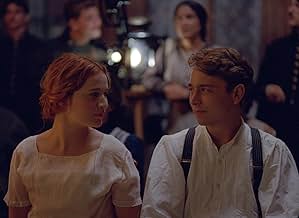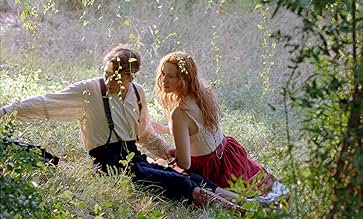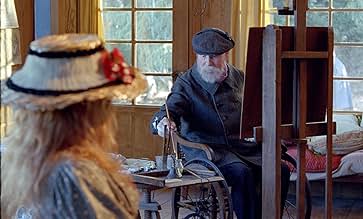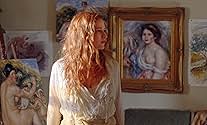CALIFICACIÓN DE IMDb
6.5/10
6.1 k
TU CALIFICACIÓN
En el verano de 1915, Jean Renoir, hijo del pintor impresionista Pierre-Auguste, vuelve a casa tras ser herido en la guerra. Andrée es la joven revivirá tanto al hijo como al padre.En el verano de 1915, Jean Renoir, hijo del pintor impresionista Pierre-Auguste, vuelve a casa tras ser herido en la guerra. Andrée es la joven revivirá tanto al hijo como al padre.En el verano de 1915, Jean Renoir, hijo del pintor impresionista Pierre-Auguste, vuelve a casa tras ser herido en la guerra. Andrée es la joven revivirá tanto al hijo como al padre.
- Dirección
- Guionistas
- Elenco
- Premios
- 3 premios ganados y 11 nominaciones en total
Anne-Lise Heimburger
- La boulangère
- (as Annelise Heimburger)
Thierry Hancisse
- Le brocanteur
- (as Thierry Hancisse de la Comédie Française)
Cécile de Moor
- Servante Collettes
- (as Cecile Rittweger)
Opiniones destacadas
Appropriately enough, about the world's most famous Impressionist painter.
While it's definitely not for those who strongly favor conventionally plotted drama or fast action, RENOIR consists of immediate realism and puts you right with the Renoir clan on the French Riviera. It's the sort of film that could easily have been made overly artsy and dull, but it's neither.
The entire story takes place in 1915, toward the end of Renoir's life. The relationship between model Andrée Heuschling and son Jean Renoir is, in many ways, more the subject of the story than the painter himself, yet Renoir himself is indispensable as "the boss," a sort of god-like backdrop to the entire cast and story. Having said that, I must add that there is a fair amount on Renoir's artistic processes, and his philosophizing can be applied to all sorts of art-forms as well as painting. One of RENOIR's strongest aspects is its portrayal of a man who is obsessed with his work and has one thing which utterly engulfs and consumes him.
Like many French films, RENOIR succeeds in breaking all sorts of rules. Among them:
--The plot is meandering and somewhat slice-of-life but still gripping;
--Andrée, the "girl from nowhere," and free but neglected youngest son Coco are characters that beg to be developed further, but at the same time, perhaps it's better that they remain mysterious;
--Lots of female nudity without it seeming the least bit gratuitous: After all, the subject is an artist who often painted naked girls;
--The mood is a successful mesh of somberness, poignancy, and (often laugh-out-loud) humor.
Just about every artsy cliché could be applied to this film, but suffice it to say that it is a beautiful experience. Even simple colors come alive here for the audience as they did for Renoir himself. I'm a word person who's never been a big painting aficionado, but this film made me see the visual arts in a whole new light and may even have converted me to some extent. The soundtrack--quiet, unobtrusive piano scores in the background--also does a great deal to carry this film.
While it's definitely not for those who strongly favor conventionally plotted drama or fast action, RENOIR consists of immediate realism and puts you right with the Renoir clan on the French Riviera. It's the sort of film that could easily have been made overly artsy and dull, but it's neither.
The entire story takes place in 1915, toward the end of Renoir's life. The relationship between model Andrée Heuschling and son Jean Renoir is, in many ways, more the subject of the story than the painter himself, yet Renoir himself is indispensable as "the boss," a sort of god-like backdrop to the entire cast and story. Having said that, I must add that there is a fair amount on Renoir's artistic processes, and his philosophizing can be applied to all sorts of art-forms as well as painting. One of RENOIR's strongest aspects is its portrayal of a man who is obsessed with his work and has one thing which utterly engulfs and consumes him.
Like many French films, RENOIR succeeds in breaking all sorts of rules. Among them:
--The plot is meandering and somewhat slice-of-life but still gripping;
--Andrée, the "girl from nowhere," and free but neglected youngest son Coco are characters that beg to be developed further, but at the same time, perhaps it's better that they remain mysterious;
--Lots of female nudity without it seeming the least bit gratuitous: After all, the subject is an artist who often painted naked girls;
--The mood is a successful mesh of somberness, poignancy, and (often laugh-out-loud) humor.
Just about every artsy cliché could be applied to this film, but suffice it to say that it is a beautiful experience. Even simple colors come alive here for the audience as they did for Renoir himself. I'm a word person who's never been a big painting aficionado, but this film made me see the visual arts in a whole new light and may even have converted me to some extent. The soundtrack--quiet, unobtrusive piano scores in the background--also does a great deal to carry this film.
+Renoir (France, 2012, 112 min)
Gille +Bourdos uses the well-known stories of the painter father Pierre-Auguste and the filmmaker son Jean Renoir for a film that is at once breathtaking spectacle and a profound anatomy of the impulses and values of art. The film was one of my highlights at this year's +Palm Springs International Film Festival.
The plot presents the 74-year-old veteran painter (Michel Bouquet) and his ravishing new 15-year-old model, Andree Heuschling (Christa Theret) enjoying their opulent country estate while WW I pounds the humanity outside. Mark Lee Ping-Bin shoots the interiors with classic Dutch light and shadow but the exteriors in the unbridled luminosity of Impressionism. Here Renoir explains that structure comes from colour, not form, and he refuses to use black. That summarizes the painter's Impressionism: it finds reality in what he makes of the outside world, not what it firmly may be. His swirls of rosy chub continues his celebration of the young "velvet" flesh, despite the war's flensing and destruction of the flesh beyond the estate and his age's grotesque gnarl and ruin of his bones. His painting days, like his valiant denial of death, are limited.
Son Jean (Vincent Rottiers) returns from the front with a symbol of the reality his father rejects: an open wound. The family has a variety of open wounds, from the loss of the boys' mother and the favoured model/nanny Gabrielle to the sons' resentment of their father's aloofness. The cut to the bone represents the reality Renoir's fleshy ladies and painted pommes reject. Vincent's convalescence goes beyond the flesh gap to include winning Andree, who -- a closing title tells us -- married him, starred in many films (as Catherine Hessling), and after their split died alone in poverty. The sins of the father don't just visit the son but move in with him.
The tension between the painter's idealized flesh and the its horrific reality are frequently imaged, especially in the eating scenes and in the kitchen where a maid delicately peels a tomato, removing a hide to expose a succulent flesh. The hanging carrion are an implicit reminder of the hunting and killing of the human prey outside. Renoir pere screams from the nightmares he doesn't have his sunshine, models and pink paints to ward off.
Around the story of Renoir pere beats a more subtle story of Renoir fils. Like Andree, the film serves both father and son. Unobtrusively Bourdos weaves in the specific sources of Renoir's cinema. These include his sense that wars shatter natural cross-border fraternities, the harshness of the class prejudices, the increasing disrespect for culture, the necessity for art. Even the quintessential understanding which will become "The terrible thing is, everyone has his reasons." For more see www.yacowar.blogspot.
Gille +Bourdos uses the well-known stories of the painter father Pierre-Auguste and the filmmaker son Jean Renoir for a film that is at once breathtaking spectacle and a profound anatomy of the impulses and values of art. The film was one of my highlights at this year's +Palm Springs International Film Festival.
The plot presents the 74-year-old veteran painter (Michel Bouquet) and his ravishing new 15-year-old model, Andree Heuschling (Christa Theret) enjoying their opulent country estate while WW I pounds the humanity outside. Mark Lee Ping-Bin shoots the interiors with classic Dutch light and shadow but the exteriors in the unbridled luminosity of Impressionism. Here Renoir explains that structure comes from colour, not form, and he refuses to use black. That summarizes the painter's Impressionism: it finds reality in what he makes of the outside world, not what it firmly may be. His swirls of rosy chub continues his celebration of the young "velvet" flesh, despite the war's flensing and destruction of the flesh beyond the estate and his age's grotesque gnarl and ruin of his bones. His painting days, like his valiant denial of death, are limited.
Son Jean (Vincent Rottiers) returns from the front with a symbol of the reality his father rejects: an open wound. The family has a variety of open wounds, from the loss of the boys' mother and the favoured model/nanny Gabrielle to the sons' resentment of their father's aloofness. The cut to the bone represents the reality Renoir's fleshy ladies and painted pommes reject. Vincent's convalescence goes beyond the flesh gap to include winning Andree, who -- a closing title tells us -- married him, starred in many films (as Catherine Hessling), and after their split died alone in poverty. The sins of the father don't just visit the son but move in with him.
The tension between the painter's idealized flesh and the its horrific reality are frequently imaged, especially in the eating scenes and in the kitchen where a maid delicately peels a tomato, removing a hide to expose a succulent flesh. The hanging carrion are an implicit reminder of the hunting and killing of the human prey outside. Renoir pere screams from the nightmares he doesn't have his sunshine, models and pink paints to ward off.
Around the story of Renoir pere beats a more subtle story of Renoir fils. Like Andree, the film serves both father and son. Unobtrusively Bourdos weaves in the specific sources of Renoir's cinema. These include his sense that wars shatter natural cross-border fraternities, the harshness of the class prejudices, the increasing disrespect for culture, the necessity for art. Even the quintessential understanding which will become "The terrible thing is, everyone has his reasons." For more see www.yacowar.blogspot.
10Red-125
Renoir (2012) written and directed by Gilles Bourdos, tells the story of the aging painter Pierre-Auguste Renoir (Michel Bouquet), his young model Andrée (Christa Theret), and his son Jean (Vincent Rottiers).
Andrée is a free spirit. She has no problem posing in the nude, but she makes it clear to everyone that she is a paid model. She has no intention of posing for the honor of it, nor is she ready to become a cook or a maid, as have other models before her.
Naturally, Jean is drawn to the beautiful young woman, and the plot revolves around the relationships among and between the three main characters.
This is an extraordinarily beautiful movie, filmed on the scenic Côte d'Azur. War is raging elsewhere in France, but life is peaceful in this region. The pace of the film reflects the pace of life at the time--quiet and slow.
This is a film worth seeing, based on historical fact, and suggesting what motivated the younger Renoir to become the extraordinary film director that he was. For some reason, the IMDb weighted average of this film is a dismal 6.6. (The ratings themselves are much higher, but the weighting system brings the number down.) Don't be discouraged by the low rating. This is a movie worth seeking out and seeing. It will work better in a theater, but, if necessary, see it on DVD. It will repay your viewing.
Andrée is a free spirit. She has no problem posing in the nude, but she makes it clear to everyone that she is a paid model. She has no intention of posing for the honor of it, nor is she ready to become a cook or a maid, as have other models before her.
Naturally, Jean is drawn to the beautiful young woman, and the plot revolves around the relationships among and between the three main characters.
This is an extraordinarily beautiful movie, filmed on the scenic Côte d'Azur. War is raging elsewhere in France, but life is peaceful in this region. The pace of the film reflects the pace of life at the time--quiet and slow.
This is a film worth seeing, based on historical fact, and suggesting what motivated the younger Renoir to become the extraordinary film director that he was. For some reason, the IMDb weighted average of this film is a dismal 6.6. (The ratings themselves are much higher, but the weighting system brings the number down.) Don't be discouraged by the low rating. This is a movie worth seeking out and seeing. It will work better in a theater, but, if necessary, see it on DVD. It will repay your viewing.
Normally I love French films, especially those set in the beautiful countryside, and I did enjoy the cinematography in this film, but.....something was really lacking for me. Other reviewers have said the same - an unfortunate lack of drama or excitement, in a plodding but beautiful film. Not much development of the characters - we are left wondering about the various females in the household and their feelings. The wounded son displays a curiously restrained demeanor in the film, not saying a whole lot, and the younger son is portrayed as somewhat odd and neglected, but I did not read anything about his neglect in other biographies of Renoir, and his strange behavior seemed to have no point in the film. I found it hard to sit through the whole film, constantly expecting something to happen. One moment of strong emotion by Andree did not lead to anything much afterward. The constant focus on Renoir's horribly disfigured hands was probably essential but disturbing. I would have liked some scenes with flashbacks to his youth and success as a painter, to give this film some more life. At the time I really felt that I did not like the film, but I keep thinking back on the scenes, so it was worth seeing.
Greetings again from the darkness. Admittedly, I expect more from independent films since there is usually no committee of producers sucking the life out of the filmmaker's vision. While writer/director Gilles Bourdos teams with Cinematographer Ping Bin Lee to deliver a film that carries the visual beauty of its subject's paintings, it somehow offers little else.
Veteran French actor Michel Bouquet captures the essence of a 74 year old Pierre-Auguste Renoir, a master Impressionistic artist. By this time (1915), Renoir is in constant pain and continues painting despite his gnarled hands courtesy of severe arthritis. He has relocated to Cote D'Azur (the French Riviera) to leave in peace with nature and the warmer weather. His estate is gorgeous and provides the backdrops for many paintings. We meet his newest model, 15 year old Andree Heuschling (Christa Theret). Her spirit inspires not just Renoir the artist, but also his son Jean (Vincent Ruttiers), sent home to recover from his WWI injuries.
Both father and son seem to objectify the beautiful and spirited Andree, neither being capable of an adult and equal personal relationship. The frustration with this movie stems from its unwillingness to offer anything other than observations of its characters. It meanders through days with no real purpose or insight. This despite having subjects that include one of the greatest artists of all-time and his son, who went on to become a world famous movie director. The story, if there is one, just kind of lays there flat, surrounded by beautiful colors and textures.
Auguste Renoir died in 1919, but earlier that year managed to visit the Louvre and view his own paintings hanging in the majestic halls. Jean Renoir married Andree and cast her in his first silent films (as Catherine Hessling). When the films flopped, they divorced. She went on to a life of obscure poverty, and he directed two of the greatest films in history: Grand Illusion and The Rules of the Game.
Alexandre Desplat provides another fine score, leaving us lacking only a story or point to the film. To learn much about Pierre-Auguste Renoir, it is recommended to read the biography his son Jean wrote.
Veteran French actor Michel Bouquet captures the essence of a 74 year old Pierre-Auguste Renoir, a master Impressionistic artist. By this time (1915), Renoir is in constant pain and continues painting despite his gnarled hands courtesy of severe arthritis. He has relocated to Cote D'Azur (the French Riviera) to leave in peace with nature and the warmer weather. His estate is gorgeous and provides the backdrops for many paintings. We meet his newest model, 15 year old Andree Heuschling (Christa Theret). Her spirit inspires not just Renoir the artist, but also his son Jean (Vincent Ruttiers), sent home to recover from his WWI injuries.
Both father and son seem to objectify the beautiful and spirited Andree, neither being capable of an adult and equal personal relationship. The frustration with this movie stems from its unwillingness to offer anything other than observations of its characters. It meanders through days with no real purpose or insight. This despite having subjects that include one of the greatest artists of all-time and his son, who went on to become a world famous movie director. The story, if there is one, just kind of lays there flat, surrounded by beautiful colors and textures.
Auguste Renoir died in 1919, but earlier that year managed to visit the Louvre and view his own paintings hanging in the majestic halls. Jean Renoir married Andree and cast her in his first silent films (as Catherine Hessling). When the films flopped, they divorced. She went on to a life of obscure poverty, and he directed two of the greatest films in history: Grand Illusion and The Rules of the Game.
Alexandre Desplat provides another fine score, leaving us lacking only a story or point to the film. To learn much about Pierre-Auguste Renoir, it is recommended to read the biography his son Jean wrote.
¿Sabías que…?
- TriviaOfficial submission of France to the Oscars 2014 best foreign language film category.
- ErroresWhen Pierre-Auguste walks in on Jean Renoir being bathed, a modern toggle-style light switch is visible on the wall. The toggle switch wasn't invented until 1917, which is a few years after that part of the film. Earlier light switches were push-button style, and the switch on the wall is also of a modern plastic style that is very much later.
- Citas
Pierre-Auguste Renoir: You're rather modest for an actress.
Andrée Heuschling: Actress doesn't mean whore.
- ConexionesFeatured in Fandor: Cannes You Dig It? | Fandor Spotlight (2022)
- Bandas sonorasShimmy Dédée
By Patrick Artero
Performed by Patrick Artero, Philippe Baudouin, Francis Guero, André Neufert and Michel Queraud
Selecciones populares
Inicia sesión para calificar y agrega a la lista de videos para obtener recomendaciones personalizadas
- How long is Renoir?Con tecnología de Alexa
Detalles
- Fecha de lanzamiento
- País de origen
- Sitio oficial
- Idiomas
- También se conoce como
- 印象雷諾瓦
- Locaciones de filmación
- Productoras
- Ver más créditos de la compañía en IMDbPro
Taquilla
- Total en EE. UU. y Canadá
- USD 2,293,798
- Fin de semana de estreno en EE. UU. y Canadá
- USD 65,194
- 31 mar 2013
- Total a nivel mundial
- USD 7,816,573
- Tiempo de ejecución1 hora 51 minutos
- Color
- Mezcla de sonido
- Relación de aspecto
- 1.85 : 1
Contribuir a esta página
Sugiere una edición o agrega el contenido que falta

































